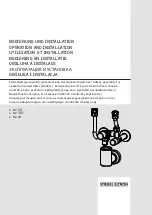
4.6.3.
Hydraulic connection of the water circuit
for domestic use
1. Remove the anti-dust plug located on the domestic cold water
connection
x
under the boiler.
2. Remove the anti-dust plug located on the domestic hot water
connection
y
under the boiler.
3. Connect the cold water inlet pipe to the domestic cold water
connection. Install a safety unit labelled KIWA on this pipe directly
under the boiler.
4. Place a tube, connected to the drains, underneath the safety unit
for water from expansion.
5. Connect the domestic hot water outlet pipe to the domestic hot
water connection.
CAUTION
4
The domestic water pipes must be connected in
accordance with prevailing provisions.
4
If using synthetic pipes, follow the manufacturer's
(connection) instructions.
4.6.4.
Connecting the expansion vessel
Install the expansion vessel on the heating return pipe
z
.
If using a heating and domestic hot water production type
boiler on an installation in which the flow can be fully
disconnected from the return (e.g. by using thermostatic
valves), you should either fit a bypass or fit an expansion
vessel to the heating flow conduit.
4.6.5.
Connecting the condensate discharge pipe
1. Mount a standard drainage pipe, Ø 32 mm or more, leading to the
mains drainage system.
2. Into this, insert the condensate collector hose coming from the
siphon
j
and the safety valve
ê
.
3. Mount a trap or a siphon in the discharge pipe.
CAUTION
Do not make a fixed connection owing to maintenance
work on the siphon.
4
Do not plug the condensate discharge pipe.
4
Set the discharge pipe at a gradient of at least 30 mm
per metre, maximum horizontal length 5 metres.
4
Do not drain condensation water into a roof gutter at
any time.
4
Connect the condensate discharge pipe in
accordance with prevailing standards.
T001572-B
T001571-C
Calenta 25s - 28c - 35s - 40c
4. Installation
040412 - 7600585-01
31
















































